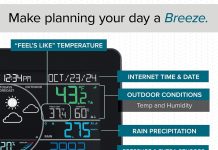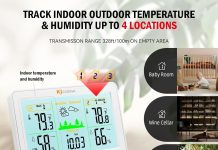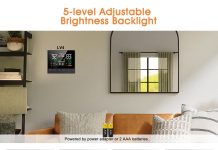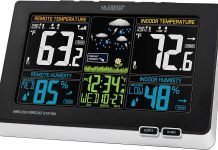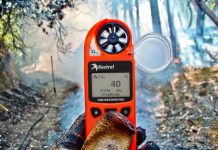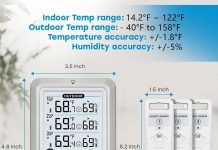Ready to take your home weather station to the next level? Whether you’re a weather enthusiast or just want to stay on top of the local forecast, finding the perfect spot to mount your device is crucial for accurate readings. From the backyard to the rooftop, we’ve explored all the possible options to help you determine where your home weather station will thrive. Join us on this journey as we uncover the best place to mount your very own weather station, so you can enjoy reliable weather updates right at your fingertips.
Review contents
Factors to Consider
When deciding on the best place to mount a home weather station, there are several factors that should be taken into consideration. These factors include accuracy, exposure, accessibility, obstructions, and maintenance. By carefully evaluating each of these factors, you can ensure that your weather station is installed in an optimal location.
Accuracy
The accuracy of your weather station readings is of utmost importance. To achieve accurate measurements, it is crucial to choose a mounting location that is not overly affected by external factors. Avoid areas with excessive heat sources, such as asphalt or concrete, as they can skew temperature readings. Additionally, select a location that is not prone to significant temperature fluctuations throughout the day.
Exposure
The exposure of your weather station to the elements is another critical factor to consider. The station should be placed in an area that provides a representative sample of the surrounding weather conditions. Avoid locations that are shielded or isolated, as they may not accurately capture wind speed, rainfall, or other weather-related data. Find a spot that strikes a balance between being exposed to the elements and being protected from extreme weather conditions.
Accessibility
Mounting your weather station in an easily accessible location is essential for regular maintenance and troubleshooting. Ensure that the location you choose allows for easy access to change batteries, clean sensors, and perform any necessary repairs or adjustments. Consider proximity to power outlets and internet connectivity if your weather station requires them.
Obstructions
The presence of obstacles or obstructions around your chosen mounting location can significantly impact the accuracy and reliability of your weather station readings. Be mindful of tall structures, dense vegetation, or nearby walls that might block wind flow or create reflections. Such obstructions can disrupt the airflow, leading to inaccurate wind speed and direction measurements or reflections that interfere with temperature and humidity readings.
Maintenance
Proper maintenance is crucial to keeping your home weather station functioning optimally. When selecting a mounting location, consider the ease of carrying out routine maintenance tasks. This includes cleaning sensors, replacing batteries, and ensuring connectivity to other devices. Accessibility and proximity to required resources are key factors in ensuring that maintenance can be performed efficiently.
Outdoor Mounting Locations
Mounting your weather station outdoors provides an accurate representation of the weather conditions in your immediate surroundings. There are several outdoor locations to consider, including open areas, rooftops, poles, fences, and gardens.
Open Area
An open area away from obstructions, such as tall buildings or dense trees, is an ideal location for mounting your weather station. This allows for unobstructed wind flow and accurate wind speed and direction measurements.
Roof
Mounting your weather station on the roof offers a vantage point that provides comprehensive exposure to the weather. However, ensure that the roof is easily accessible for maintenance and protected to prevent direct sunlight exposure.
Pole
A pole mount can be an excellent option for maximizing exposure to different weather conditions. By placing the weather station on a pole, you can elevate it to obtain readings free from ground-level influences.
Fence
Mounting your weather station on a fence can be a convenient and accessible option. Ensure that the fence location is representative of the surrounding area and is not subject to additional obstructions.
Garden
If you have a garden space, consider mounting your weather station in an open area within it. This allows for a combination of open exposure and natural surroundings, providing accurate measurements.
Indoor Mounting Locations
In some cases, mounting your weather station indoors may be more feasible or desirable. Indoor mounting is particularly suitable for those living in apartments or areas with limited outdoor space. Here are a few indoor locations to consider:
Living Room
The living room is a central area within most homes, making it a convenient location for an indoor weather station. Ensure that the station is placed away from direct airflow from an air conditioning unit or heating source.
Kitchen
The kitchen is often one of the busiest areas in a home. Mounting your weather station here allows for constant monitoring while going about daily activities. However, be mindful of heat sources like stoves or ovens that may affect temperature readings.
Bedroom
For those who want to wake up to weather updates, mounting the weather station in the bedroom can be a viable option. Make sure the station is placed away from any electronics or gadgets that emit heat.
Home Office
If you have a dedicated home office, consider mounting your weather station in this space. This allows for easy monitoring while working and quick access to data during productive hours.
Basement
Mounting your weather station in the basement can be a practical solution if you lack outdoor or indoor space. However, keep in mind that basement conditions may differ significantly from the outdoor environment, potentially affecting the accuracy of measurements.
Considerations for Outdoor Mounting
When mounting your weather station outdoors, there are several important considerations to keep in mind to ensure accurate and reliable readings.
Unobstructed Sky view
An unobstructed view of the sky is crucial for accurate weather measurements. Choose a location that provides a clear line of sight to the sky in all directions. Avoid areas surrounded by tall buildings, trees, or other structures that could block the view and potentially affect readings.
Protection from Direct Sunlight
Direct sunlight can raise temperatures and affect temperature and humidity measurements. To prevent inaccuracies, choose a location that offers some shade or provides shelter for the weather station. Consider mounting it under an overhang, awning, or tree canopy.
Avoiding Reflections
Reflections can interfere with temperature and humidity readings, leading to inaccuracies. Ensure that the chosen location does not have reflective surfaces nearby, such as windows or mirrors. These can amplify or distort the reflected radiation received by your station’s sensors.
Distance from Structures
To achieve accurate wind speed and direction readings, it is important to mount the weather station a sufficient distance away from tall structures or buildings. These structures can create turbulence and disrupt the natural airflow, resulting in distorted measurements. Aim for a distance of at least ten times the height of surrounding structures.
Considerations for Indoor Mounting
When mounting your weather station indoors, specific considerations should be taken into account to ensure accurate and reliable readings.
Central Location
Choose a central location within your home to mount the weather station. This will provide a representative sample of the indoor environment and ensure that the readings reflect the overall conditions of your living space.
Avoiding Heat Sources
Avoid placing the weather station near heat sources such as radiators, stoves, or direct sunlight. Heat sources can artificially increase temperature readings and impact the accuracy of your weather station’s measurements.
Avoiding Direct Airflow
Direct airflow from air conditioning units, fans, or open windows can affect temperature and humidity readings. Mount the weather station away from these sources to minimize any potential interference.
Protection from Moisture
To ensure the longevity and accuracy of your weather station, choose a location that is protected from moisture. Avoid areas prone to high humidity, such as bathrooms or kitchens, as excess moisture can damage the station’s sensors and affect readings.
Mounting Options
Depending on the available space and the specific requirements of your weather station, there are several mounting options to consider.
Wall Mounting
Wall mounting offers a secure and space-saving solution. Install mounting brackets on a wall and attach the weather station securely. Ensure that the chosen wall can support the weight of the station and provide easy access for maintenance.
Pole Mounting
Mounting your weather station on a pole allows for elevation and unobstructed exposure to the elements. Ensure that the pole is sturdy and able to support the weight of the station. Choose a location where the pole won’t be affected by vibrations or movements.
Tripod Mounting
Tripod mounting offers flexibility and portability. Set up a tripod in the desired location, ensuring stability and level positioning. This option is particularly useful when moving your weather station around or testing different locations.
Ceiling Mounting
Ceiling mounting is an alternative option for indoor installations. Securely attach the weather station to the ceiling, ensuring it is not obstructed by any furniture or decorations. Ceiling mounting provides a different perspective and can be an effective way to monitor indoor conditions.
Recommended Height
The height at which your weather station is mounted can impact the accuracy and reliability of the measurements obtained. Several factors should be considered when determining the optimal height for your weather station.
Weather Station Requirements
Refer to the manufacturer’s guidelines and recommendations for the minimum and maximum mounting height for your specific weather station model. Different stations may have varying requirements for optimal performance.
Building Regulations
If you are installing the weather station on a building or structure, be aware of any local building regulations or restrictions regarding height limitations. Compliance with these regulations is essential to ensure the safety and legality of the installation.
Local Obstructions
Consider the immediate surroundings of your chosen location. Ensure that the height allows for proper exposure to wind and other weather conditions while minimizing the influence of nearby obstructions, such as trees or neighboring buildings. Assess the potential impact of nearby structures on wind direction measurements and adjust the height accordingly.
Installation Tips
Proper installation of your home weather station is crucial for accurate and reliable readings. Here are some installation tips to ensure optimal performance.
Secure Mounting
Ensure that your weather station is securely mounted to prevent any movement or vibrations that may affect the accuracy of the measurements. Follow the manufacturer’s instructions regarding the proper attachment of the station to the chosen mount.
Leveling the Station
Maintaining a level position is essential for accurate readings. Use a spirit level to ensure that your weather station is perfectly level. This will help prevent any measurement discrepancies caused by an uneven or tilted installation.
Cable Management
Proper cable management is important for maintaining a tidy and organized installation. Securely fasten any cables or wires, ensuring they are protected from environmental factors such as moisture or excessive heat.
Sealing and Protection
When installing your weather station, take measures to protect it from the elements. This may involve applying a sealant or protective coating to vulnerable areas to prevent moisture damage. Consider using weatherproof enclosures for outdoor installations to shield the station from rain or snow.
User Experiences
To gain insights into the best place to mount a home weather station, it can be helpful to consider user experiences.
User Observations
Many users have reported that mounting the weather station in an open area away from obstructions provides the most accurate readings. Users often highlight the importance of unobstructed sky view, protection from direct sunlight, and avoiding reflective surfaces.
Common Problems
Users have occasionally encountered challenges with inaccurate temperature readings when the weather station was placed near heat sources or directly exposed to airflow from air conditioning units. Additionally, some users have reported connectivity issues when the station was mounted too far from the indoor receiver or wireless router.
Popular Solutions
Users have found success by ensuring the weather station is mounted at an adequate distance from tall structures and is shielded from direct sunlight. Mounting the station in central locations within the home, away from heat sources and direct airflow, has also been a common solution to the problems mentioned. Users have emphasized the importance of following manufacturer guidelines and recommendations to maximize the performance of the weather station.
Conclusion
When determining the best place to mount your home weather station, consider the factors of accuracy, exposure, accessibility, obstructions, and maintenance. Whether you choose an outdoor location like an open area, roof, pole, fence, or garden, or an indoor location such as the living room, kitchen, bedroom, home office, or basement, it’s essential to ensure that the mounting location meets the specific considerations discussed. Proper installation, adherence to guidelines, and regular maintenance will contribute to accurate and reliable weather readings, allowing you to make informed decisions based on the collected data.


